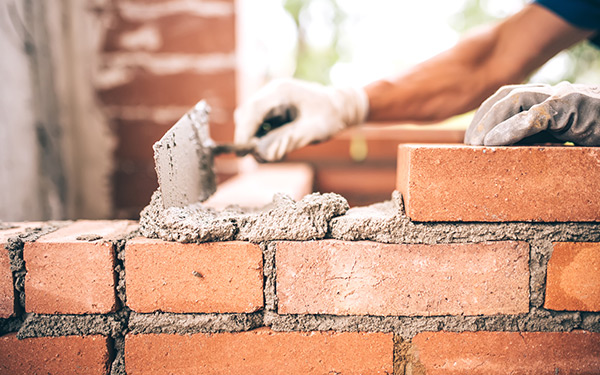Opening the Keys of Lasting Stonework Building And Construction Practices for Eco-Friendly Buildings
In the world of modern building and construction, the quest of sustainable methods has actually come to be vital. Amongst the myriad techniques to environmentally friendly structure, lasting stonework building sticks out as a tried and true and resilient method that holds a wide range of untapped possibility. From the choice of materials to cutting-edge construction strategies, the keys to attaining sustainability within stonework building and construction are multifaceted and fascinating. By checking out the advantages, products, methods, and future patterns of lasting stonework, a much deeper understanding of just how these practices can form the future of green structures emerges.
Benefits of Sustainable Stonework Construction
Embracing sustainable masonry building and construction practices not just reduces ecological influence however also uses lasting economic benefits to home builders and neighborhoods. By making use of products like recycled blocks, blocks, and stones, home builders can substantially lower the carbon footprint of their projects while promoting resource efficiency. Furthermore, sustainable masonry building methods, such as appropriate insulation and thermal mass residential or commercial properties, can enhance energy effectiveness within structures, bring about lowered operational prices over time.
In addition, the resilience and resilience of masonry structures add to lasting financial advantages. Structures built utilizing sustainable stonework techniques commonly call for less repair and maintenance, converting to set you back financial savings for building contractors and home owners. The long life of stonework products additionally makes certain that structures remain secure and protected, reducing the demand for frequent improvements or substitutes.
Eco-Friendly Stonework Materials
Making use of green stonework materials is an essential step towards improving the sustainability of building practices and minimizing ecological effect while making the most of lasting economic advantages. Sustainable masonry materials are sourced, created, and used in a way that reduces total ecological impact. Materials such as recycled blocks, reclaimed stone, and sustainable cinder block are becoming significantly preferred choices for eco-conscious building contractors. Recycled blocks, for instance, not only divert waste from garbage dumps but also call for less energy to generate contrasted to new bricks. Redeemed stone uses an unique aesthetic appeal while minimizing the requirement for new quarrying. Lasting concrete blocks incorporate recycled aggregates and may include enhanced insulation residential or commercial properties, contributing to power performance in structures.
Additionally, all-natural materials like adobe, rammed earth, and straw bundles offer outstanding thermal mass properties, minimizing the requirement for heating and cooling down power. These materials are commonly in your area available, promoting local economies and minimizing transportation-related carbon exhausts. By selecting environment-friendly stonework products, construction jobs can substantially lower their environmental impact and add to the development of much healthier, more sustainable developed settings.
Energy-Efficient Masonry Techniques
Power efficiency plays an important function in boosting the sustainability of masonry construction practices. By carrying out energy-efficient stonework techniques, home builders can dramatically decrease the total energy usage of a structure, causing lower functional expenses and a visit site smaller environmental impact. One crucial energy-efficient stonework strategy is using thermal mass, which involves including thick products like concrete or brick into the building's framework to absorb and save warm. This helps manage interior temperature levels, minimizing the demand for mechanical home heating and cooling systems.

Innovations in Sustainable Masonry
Current advancements in sustainable masonry methods have caused cutting-edge methods that are improving the construction market. One such technology is the development of self-healing concrete, which uses germs installed within the concrete his comment is here to recover splits autonomously. This advancement not just minimizes upkeep expenses yet additionally enhances the sturdiness of stonework structures, adding to their sustainability.
One more noteworthy technology is using recycled accumulations in stonework building and construction - masonry contractor. By incorporating materials such as smashed ceramic waste or recycled glass right into concrete blends, home builders can lower the ecological impact of building jobs while keeping structural honesty. This method not just diverts waste from garbage dumps yet also conserves natural deposits, making it a key advancement in sustainable masonry building
In addition, the combination of electronic design devices, such as Building Information Modeling (BIM), is revolutionizing the way masonry frameworks are planned and constructed. BIM permits even more specific estimations, minimized material wastage, and improved energy efficiency, inevitably resulting in more sustainable building methods. These developments collectively symbolize an encouraging future for sustainable masonry construction in the age of green structures.
Future Trends in Masonry Sustainability
With the cutting-edge strides made in lasting stonework practices, the future trends in masonry sustainability are positioned to more transform the building sector. Among the crucial trends forming the future of stonework sustainability is the raised combination of technology. Improvements such as Structure Info Modeling (BIM) and virtual fact simulations are being utilized to maximize stonework building and construction procedures, resulting in lowered material waste and enhanced power effectiveness in structures.
Moreover, the development of novel sustainable products is readied to play a substantial function in improving the eco-friendliness of stonework construction. masonry contractor. Advancements like self-healing concrete, Read More Here recycled accumulations, and bio-based binders are obtaining grip for their capability to reduce environmental effect while maintaining structural stability

Final Thought
Finally, lasting masonry building techniques use countless benefits for environment-friendly buildings. By utilizing environment-friendly materials and energy-efficient strategies, stonework can contribute to a more sustainable built environment. Developments in lasting masonry are constantly being developed to better enhance the environmental efficiency of structures. Looking in the direction of the future, the pattern of stonework sustainability is expected to grow, bring about even more eco pleasant and energy-efficient building practices in the years to find.